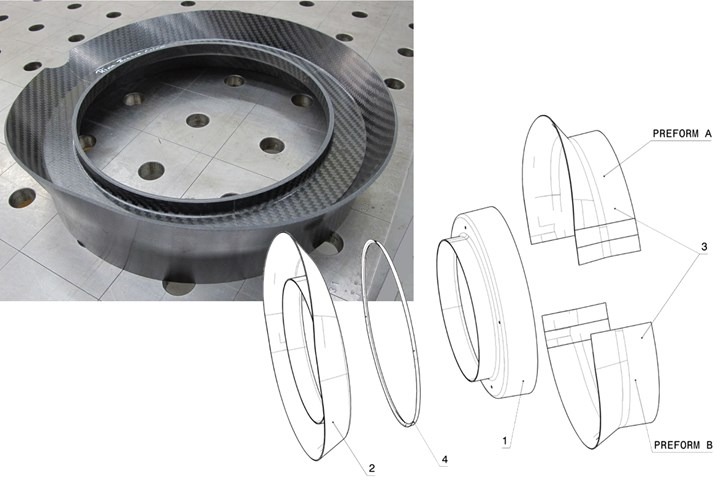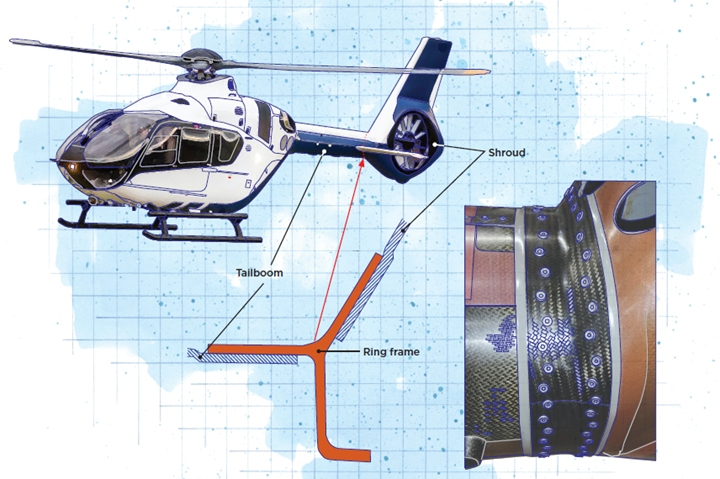Phone: +86 21 51559030
contact@galleon.cc
Composite Ring Frame Improves Safety, Cost for Workhorse Helicopter
Nov 30,2021

The H135 light twin-engine helicopter is reportedly the number one emergency medical service (EMS)/air ambulance helicopter in Europe, known for its reliability, versatility and cost-competitiveness. Also used for search and rescue, military, police and support flights for wind farms and other offshore facilities, the H135 is manufactured by Airbus Helicopters in Donauwoerth, Germany, and features the company¡¯s signature Fenestron shrouded tail rotor. Touted by Airbus Helicopters as having the lowest operating and maintenance costs in its class, more than 1,350 H135 helicopters are in service in more than 60 countries, and are relied on by more than 300 operators.
Over the years, as the H135 fleet increased in flight hours, routine maintenance at regular intervals revealed that fatigue and corrosion problems could arise on the aluminum ring frame that connects the carbon fiber-reinforced polymer (CFRP) tailboom to the CFRP tail rotor shroud. This required more detailed inspection and increased maintenance costs. To improve inspection and increase the safety standard for the H135, Airbus Helicopters looked for a corrosion- and fatigue-resistant design.
The H135 light twin-engine helicopter is reportedly the number one emergency medical service (EMS)/air ambulance helicopter in Europe, known for its reliability, versatility and cost-competitiveness. Also used for search and rescue, military, police and support flights for wind farms and other offshore facilities, the H135 is manufactured by Airbus Helicopters in Donauwoerth, Germany, and features the company¡¯s signature Fenestron shrouded tail rotor. Touted by Airbus Helicopters as having the lowest operating and maintenance costs in its class, more than 1,350 H135 helicopters are in service in more than 60 countries, and are relied on by more than 300 operators.
Over the years, as the H135 fleet increased in flight hours, routine maintenance at regular intervals revealed that fatigue and corrosion problems could arise on the aluminum ring frame that connects the carbon fiber-reinforced polymer (CFRP) tailboom to the CFRP tail rotor shroud. This required more detailed inspection and increased maintenance costs. To improve inspection and increase the safety standard for the H135, Airbus Helicopters looked for a corrosion- and fatigue-resistant design.

Meeting design and production requirements
Developing the design for the ring frame presented several issues. The ring frame is a primary structure that connects the tailboom tube with the tailboom shroud. Because the new ring frame replaces an existing part where the surrounding structure could not be changed, design options were limited. ¡°We could not change the tailboom design or the shroud in the interface area,¡± notes Thomas Kunkel, from the Donauwoerth structures design office. ¡°We had to make a part with the same connecting surfaces and dimensions, but we could change the riveting pattern and the number of rivets.¡±
After meeting with design, stress and production engineers, the team had enough information to proceed with evaluating RTM, VAP and prepreg. ¡°Our early analysis showed that VAP would be the cheapest way to go,¡± says Franz Stadler, Donauwoerth innovation department. ¡°So, we then started to develop with the designers a part which we could produce with low recurring costs. We also tried to reduce the tooling costs as much as possible. Therefore, we looked for some standard materials that we already had in production and with which we already had experience.¡±
The dry carbon fiber fabrics the team chose were already used in other Airbus Helicopter programs. ¡°The strength and sizing models were already well known by our stress department and test laboratory,¡± says Hans Otto, from Donauwoerth¡¯s industrialization department. The G0986 2x2 twill fabric from Hexcel (Stamford, Conn., U.S.) is stabilized with epoxy binder and is well-suited to preforming for resin infusion. The resin selected for infusion is Hexcel¡¯s one-component RTM6 epoxy that is qualified by Airbus Helicopters for resin infusion and RTM.
After meeting with design, stress and production engineers, the team had enough information to proceed with evaluating RTM, VAP and prepreg. ¡°Our early analysis showed that VAP would be the cheapest way to go,¡± says Franz Stadler, Donauwoerth innovation department. ¡°So, we then started to develop with the designers a part which we could produce with low recurring costs. We also tried to reduce the tooling costs as much as possible. Therefore, we looked for some standard materials that we already had in production and with which we already had experience.¡±
The dry carbon fiber fabrics the team chose were already used in other Airbus Helicopter programs. ¡°The strength and sizing models were already well known by our stress department and test laboratory,¡± says Hans Otto, from Donauwoerth¡¯s industrialization department. The G0986 2x2 twill fabric from Hexcel (Stamford, Conn., U.S.) is stabilized with epoxy binder and is well-suited to preforming for resin infusion. The resin selected for infusion is Hexcel¡¯s one-component RTM6 epoxy that is qualified by Airbus Helicopters for resin infusion and RTM.
Under this background, the 7th Annual Aeronautical Materials and Manufacturing Technology International Forum 2021 will be held on December 2nd - 3rd, 2021, in Shanghai. You are welcome to participate.
Click here to register your interest or contact with LUCY directly.
